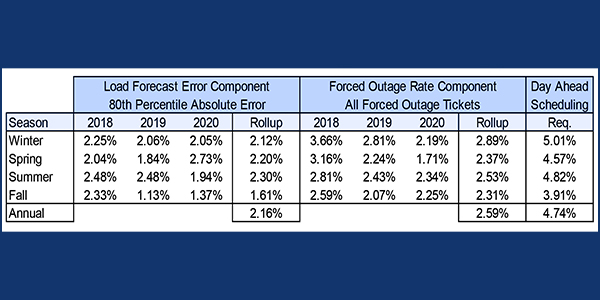PJM stakeholders last week unanimously endorsed proposed changes to the 2021 day-ahead scheduling reserve (DASR) requirement that saw small changes from last year.
David Kimmel, PJM senior engineer of performance compliance, reviewed the preliminary proposed changes at last week’s Operating Committee meeting, along with updates to Manual 13.
The DASR is the sum of the requirements for all zones within PJM and any additional reserves scheduled in response to a weather alert or other conservative operations. It is the sum of the three-year averages of both the under-forecasted load forecast error (LFE) and eDART forced outages.
Kimmel said the final 2021 DASR requirement is 4.74%, slightly lower than the 2020 requirement of 5.07%. He said the number comes from the LFE component of 2.16%, which is up 0.01% from last year, and the forced outage component of 2.59%, down 0.33% from last year.
The final 2021 DASR value will be incorporated into Manual 13 changes and be implemented in January.
Winter Weekly Reserve Target
The committee also unanimously endorsed changes to the 2020/21 winter weekly reserve target, which changed slightly from last year’s.
Patricio Rocha Garrido of PJM reviewed the results of the winter weekly reserve target analysis. The targets for December, January and February are 23%, 27% and 23%, respectively, compared to 22%, 28% and 24% last year.
“These increases and decreases are based on the load uncertainty we have in our most recent reserve requirement study case,” Rocha Garrido said. “However, the values are very close, so it doesn’t make much of an impact.”
Part of the reserve requirement study, the targets help staff coordinate planned generator maintenance scheduling and cover against uncertainties by ensuring that the loss-of-load expectation (LOLE) for winter is “practically zero,” Rocha Garrido said. For the entire year, PJM sets the LOLE at one occurrence in 10 years.
The winter weekly reserve target for each month is the highest weekly reserve percentage, Rocha Garrido said, rounded up to the next integer value.
Manual Endorsements
Stakeholders also unanimously endorsed several minor manual changes.
- Maria Baptiste of PJM reviewed updates to Manual 3A: Energy Management System Model Updates and Quality Assurance. Baptiste said the changes include correcting grammatical mistakes and updating references to the behind-the-meter generation rules that took effect in September 2019. (See “Non-retail BTM Generation Rules Endorsed,” PJM MRC/MC Briefs: Sept. 26, 2019.)
- Lagy Mathew of PJM reviewed updates to Manual 3: Transmission Operations. Mathew said the changes featured minor clarifications, including defining extra-high voltage lines as those equal to or greater than 345 kV.
- Kevin Hatch of PJM reviewed updates to Manual 12: Balancing Operations to address changes from the Market Implementation Committee’s special sessions on five-minute pricing and dispatch. Hatch said the RTO has been working with the Independent Market Monitor to identify sections of Manual 12 to be updated and to improve transparency on the dispatch process. Hatch said the changes include updated terminology for “day-ahead market” instead of the outdated “two-pass system.”




